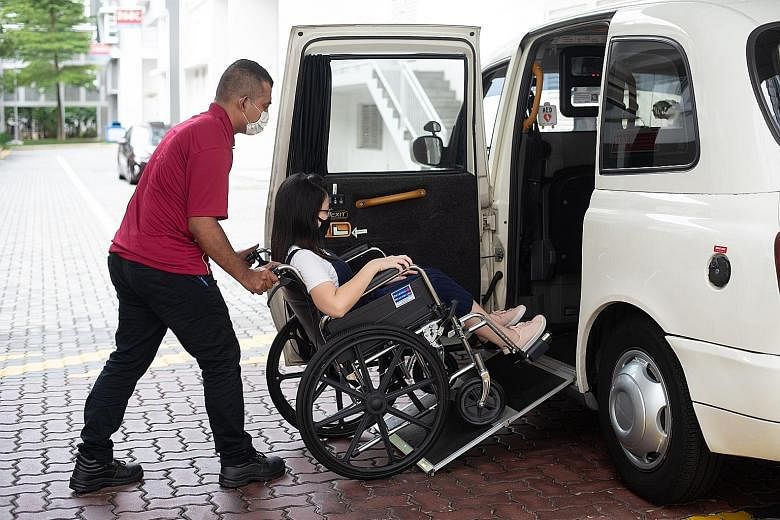Getting around late at night when you are a wheelchair user can be a nightmare - something that Ms Mel Kaur knows all too well.
The 32-year-old stays out past midnight with friends only once a year - for Universal Studios Singapore's Halloween Horror Night - as heading home once trains and buses stop running is too much of a hassle.
Ms Kaur said that for her as a motorised wheelchair user, the easiest option is to book a Maxi cab in advance, but that means deciding days ahead the time that she would be going home, and forking out between $50 and $70.
For most people, missing a scheduled ride would mean just getting another taxi or private-hire car, but that is not an option for Ms Kaur as few vehicles can accommodate her motorised wheelchair.
There have been times when she had to loiter outside until about 5.30am in order to take the first train home.
Ms Kaur, who works in marketing, told The Straits Times: "Most motorised wheelchairs are not foldable, which means we are not able to use a (regular) car as a mode of transport.
"This means we have to carefully plan each outing, ensuring we avoid peak hours and making sure we do not miss the last bus or train."
She added: "Imagine if I am late for a meeting, or if it's raining, or if I have to go somewhere that is quite a distance from the nearest MRT station or bus stop. Being able to take a taxi (or private-hire car) should not be a privilege, but a right."
All taxis can fit foldable wheelchairs in their boot, but private-hire cars, many of which are privately owned, are more varied.
Motorised wheelchairs pose a problem as they cannot fit into nearly all cabs, including London Cabs. ComfortDelGro's Maxicabs are an exception, but they are costly and often must be booked a few days before the trip.
Vehicles under GrabAssist, a service by private-hire giant Grab that allows the user to fold a wheelchair or personal mobility aid for storage in the vehicle before getting in, likewise neglect motorised wheelchair users.
The last option is private-charter vehicles, but firms which operate them often have only a few vehicles and charge up to $100 a trip, and the vehicle must be booked weeks in advance.
When Ms Kaur tried to charter rides to and from her university about six times a month, she was told it would cost her about $1,200.
Grab recently introduced GrabAssist Plus, which does not require wheelchair users to dismount before getting in. But there are only 10 vehicles available for the trial, and trips are limited to between a passenger's home and selected healthcare institutions.
The starting fare of $32 is nearly five times that of GrabAssist's $7, and Ms Kaur noted that the limited destinations do not help wheelchair users in their regular lives outside of medical consultations.
"Our lives are not just about going to hospitals or school and work. We have a life beyond that. I strongly feel that more 'fun' help should be provided to ensure one lives a fulfilling life, giving us opportunities to explore leisure like anyone else."
A quadruple amputee who wanted to be known only as Carole Ann said she takes taxis and private-hire cars because she has not got used to taking public transport.
Ms Carole, who is 44 and unemployed, does not use her motorised wheelchair outside because of the inconvenience of getting into taxis or private-hire cars.
She has to dismount and get back on her wheelchair multiple times for each trip. To do this, she uses a transfer board to heave herself into the car, a process that takes five minutes and requires immense emotional preparation.
Ms Carole prefers to use ComfortDelGro taxis as there are relatively few GrabAssist cars. When she uses GrabAssist, she often finds herself waiting indefinitely for a ride.
Grab would not say how many of these vehicles it has, although it said the service has completed more than 50,000 trips since it was launched in 2018.
Ms Carole said: "Grab cars are not standard, so sometimes there isn't enough boot space for my foldable wheelchair.
"In general, drivers (whether of taxis or private-hire cars) sometimes are also not very conscious of my needs. Some do not get out of the vehicle to help and do not understand why I have to use only the front seat. The back door is an obstacle for me.
"Every time I take a cab, it is tiring and is a gamble."
The Land Transport Authority said all private-hire car operators must provide the option of vehicles with sufficient boot space for foldable wheelchairs, under regulations implemented last October.
But it added: "A balance has to be maintained in the provision of such services to keep them affordable and at the same time financially sustainable for the service provider.
"Commuters who need help with transport costs can apply for the Ministry of Social and Family Development's Taxi Subsidy Scheme, which can be used for both taxi and private-hire car rides."
The scheme, administered by SG Enable, subsidises up to 80 per cent of fares but applies only to trips to school, work and training courses, or if the person is certified by a doctor to be able to travel only by taxi.
In recent years, the public transport system has become more inclusive. All bus routes are now wheelchair-friendly, with 99 per cent of public buses equipped with ramps or an automated wheelchair-lifting mechanism.
All bus interchanges, integrated transport hubs and MRT stations also have barrier-free access routes.
For wheelchair users, being able to get into a car without dismounting - at a reasonable price - is the next step in Singapore's bid for inclusivity.


